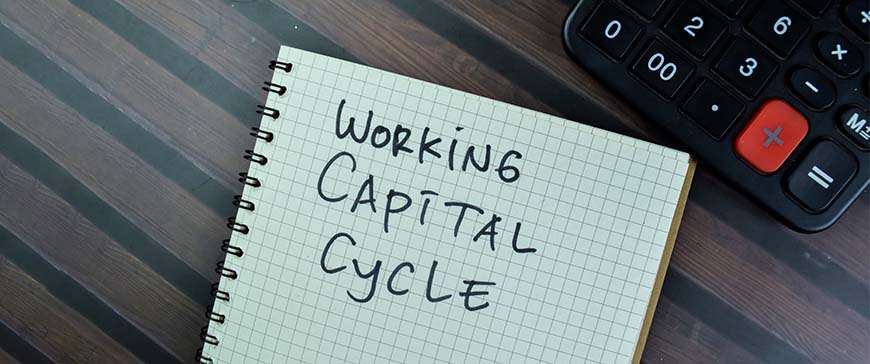Running a business often seems like juggling multiple responsibilities at a time. You need to pay the due to your suppliers who will produce the goods for you, and then you need to generate the cash by selling the finished goods to the market, and this process will repeat. You must have sufficient working capital to run a business smoothly. An insufficient amount of working capital will make it difficult for companies to manage their daily business expenses. This article will discuss the working capital cycle and how you can calculate your working capital with the working capital cycle formula. Additionally, you will also learn about tips to improve your working capital cycle and grow your business.
What Is Working Capital?
Working capital is the money a company needs to run its day-to-day operations. It consists of two parts: cash available for immediate use and accounts receivable from customers who have placed orders but haven’t yet paid for them. Working capital also considers how much inventory a company can afford to carry; if you have excess inventory, it would take your storage and cost you money without earning anything back.
What is Working Capital Cycle?
A working capital cycle is a business cycle that describes the flow of money in a business, from its suppliers to its customers. It’s also often known as the “cash flow.” The cash flow refers to the money inflow to cover your bills and expenses. It helps you understand how much money you need at any given time and helps you plan for periods when less revenue is coming in than usual.
Operating Cycle of Working Capital
The operating cycle of working capital means the time required to convert raw materials into finished products and services. It includes all the steps in the production process: buying raw materials, processing them, selling finished goods, and collecting payment for them.
The length of this cycle depends on many factors, including how quickly you can process your inventory from one stage to another, how long you keep your inventory on hand before selling it, and how fast customers pay their bills.
Four Phases of Working Capital Cycle
Here are four phases of the working capital cycle:
- Cash Management:- Cash management is a key part of running a business. The amount of money you have on hand is what helps you pay your bills, and it’s also what ensures that you have enough to manage your business expenses.
- Receivables:- Receivables are the payments you own for goods and services. They are the money you expect to receive from the people or companies that owe you money but have not yet paid.
- Inventory:- The time it takes to sell your inventory.
- Payables:- Your payables to your suppliers or vendors.
What Is Working Capital Cycle Formula?
To calculate the working capital cycle subtract the number of days the company takes to pay its suppliers from the number of days the company takes to collect the payment from customers.
The formula is: Working Capital Cycle = (Days Inventory Outstanding + Days Sales Outstanding) – Days Payable Outstanding
This number represents the amount of time a company’s resources are tied up in its day-to-day operations. A shorter cycle means more efficient use of resources.
The working capital cycle formula differs from business to business as a manufacturing industry has more phases than a retailer.
Let’s take an example of a manufacturing company; Redwood Ltd. procures raw plastics from Plastic Ltd. and then sells the finished good to retail outlets. The manufacturer procures the material on credit, and it takes 45 days to sell the finished goods to clients. Clients do not pay the money upfront but take 15 days to pay the money; manufacturers need to pay the money to suppliers as per credit terms in 30 days. So, according to the working capital cycle formula
45 (inventory Days)+ 15 (Receivable Days)- 30 (Payable Days)= 30 Days working capital cycle.
Positive vs. Negative Working Capital Cycle
The positive working capital cycle refers to a situation in which the company has more positive cash flow than it has negative cash flow. It is normal and common to most businesses. It means the company is waiting to receive payment from clients to create available cash.
On the contrary, in a negative working capital cycle, you have enough money to pay your credits before the due date. It refers to a situation in which the company has more negative cash flow than it has positive cash flow.
Shorten the Operating Cycle of Working Capital to Improve Business
A shorter working capital cycle is beneficial to your business. It enables you to utilize your cash to improve business which could otherwise be stuck in the cycle. The capital remains locked if the operational cycle is long; hence it’s important to have sufficient capital to sustain business operations.
How to Shorten the Operating Cycle of Working Capital?
You can shorten your working capital cycle in numerous ways:
Handle Inventory Smartly: Buy in-demand stock at a good price, and don’t buy bulk stocks. Calculate the number of days it takes for your inventory to sell off. If it takes 60 or more days, you need to work on your sales strategies to reduce your inventory time.
Collect Payments Early: Try to collect money early than the due date by incentivizing customers who pay early and chasing those who pay late.
Pay Bill on Time: To maintain a good credit score, you should pay your suppliers on time but avoid paying too early.
What Can Affect the Working Capital Cycle
- Cash flow is the most important factor in a working capital cycle. It is because cash flow determines the length of time an organization needs to finance its operations, affecting how often it can pay creditors.
- Credit terms can also have an impact on working capital cycles. When you extend credit to your customers, they will be able to buy more from you than if they had to pay for their purchases upfront. The extra money you get from selling on credit will increase your cash balance and reduce your need for financing at any one time—allowing other organizations less access to those funds.
- Inventory financing involves selling goods before they are produced or delivered so that a company will have enough money available when orders come through later.
How to Improve Your Working Capital Cycle?
Steps you can consider to improve your working capital cycle:
Shorten Operating Cycle: Shorten your operating cycle to increase cash flow, generating working capital. Reduce credit terms and billing, and ask for upfront payment or deposits to shorten the operating cycle.
Never Finance Fixed Asset with Working Capital: Fixed assets are used for long-term use. These are building, equipment, vehicles, machines, land, etc. Selling a fixed asset can generate enough cash flow. Still, it’s not wise to finance a fixed asset with working capital because fixed assets are expensive, and paying for them might deplete working capital and increase the risk to the business.
Reduce Unnecessarily Expenses: Carefully analyze variable business expenses to reduce unnecessary costs. It could allow you to save more and divert your fund for business expansion and operational improvement.
Find Additional Bank Finance: You may visit the bank for low-interest rate loans for working capital. Maintaining a good credit score may help you get low-interest loans quickly from a financial institution. Get Vendor Finance from Mynd Fintech with flexible repayment terms of up to 120 days of an invoice.
Reduce Bad Debt: Bad debts are a threat to a business, reduce bad debts or uncollectible receivables to maintain your working capital. You could reduce your bad debt by increasing margins on your goods and services.
Conclusion
Without a good cash flow, your company will likely have very limited opportunities for growth. The working capital cycle illustrates that most businesses rely on an interrelated system of debt and credit. Taking insights from this will help you run your business more smoothly and cope more easily with the challenges in your business life. Despite putting in your best efforts, working capital may get affected due to unavoidable circumstances such as delayed payments from clients or suppliers. Maximize your cash flow and grow your business with Mynd Fintech.
FAQs
Q.1 Why do owners of small businesses need to understand the working capital cycle?
Ans. Small businesses need to understand the working capital cycle and its importance as it affects their company’s short-term financial health and ability to pay bills and meet their obligations. An efficient working capital cycle means better cash flow management, allowing the business to invest more in growth opportunities, pay off its debt, and maintain positive relationships with suppliers. An understanding of the working capital cycle also helps owners make informed decisions about inventory management and accounts receivable, reducing the risk of financial strain and improving overall financial stability.
Q.2 How do you manage the working capital cycle?
Ans. Here are some steps to manage the working capital cycle: 1) Monitor cash flow regularly, 2) Improve Accounts Receivable processes, 3) Manage inventory effectively, 4) Minimize Accounts Payable time, 5) Evaluate and negotiate payment terms with suppliers, 6) Use short-term financing options judiciously, 7) Continuously evaluate and optimize processes to reduce cycle time. By implementing these steps, a company can maintain a healthy working capital cycle and ensure its financial stability.
Q.3 What are the advantages of the short working capital cycle?
Ans. A short working capital cycle has many advantages, including 1) improved cash flow, 2) reduced borrowing costs, 3) increased financial flexibility, 4) reduced risk of bad debts and stock obsolescence, and 5) improved ability to take advantage of business opportunities. It also enables a business to invest in growth and improve efficiency, as well as improve its overall financial stability and credibility with investors and lenders.
Q.4 What is the difference between working capital and the working capital cycle?
Ans. Working capital refers to a company’s current assets minus its current liabilities. The working capital cycle, on the other hand, is the time it takes for a company to convert its current assets back into cash through the sales and collection of its accounts receivable and the conversion of its inventory into sales.
Q.5 What are the 4 main components of working capital cycle?
Ans. The 4 main components of the working capital cycle are 1) Accounts Receivable, 2) Inventory, 3) Accounts Payable, and 4) Cash Conversion Cycle.

